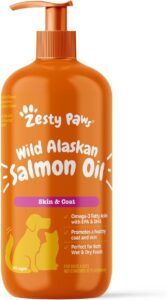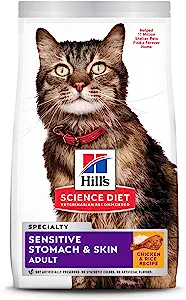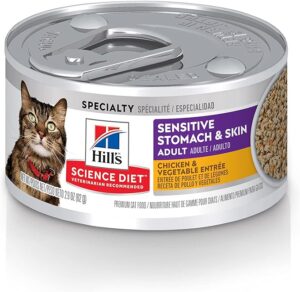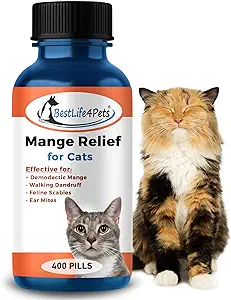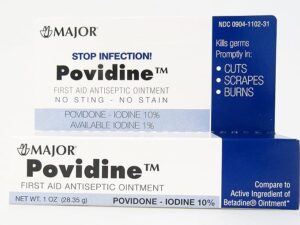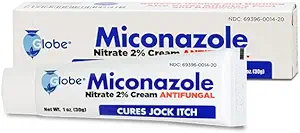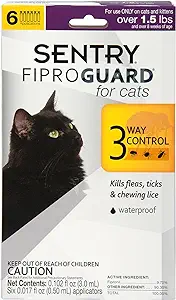Can a cat have scabs and scales on its belly?
A cat can definately have scabs and scales on its belly. Scabs and scales on the abdomen are common in cats. They arise as a result of damage to the skin on the abdomen in cats.
How do scabs and flakes form on your cat's abdomen?
If your cat suffers from scabs or scales on its belly, then there is damage to the skin. And that can be very small, but also penetrate deeper through the skin. With real injuries, blood vessels have broken and real crusts of clotted blood form on the skin. But if the skin layers themselves are damaged, moisture also seeps from the cells and their surrounding tissue of the skin. This moisture can also clump together into crusts when it dries. When the skin cells do not stick together tightly, small cracks appear in the skin. As a result, flakes can be seen. Some kind of dandruff so to speak.
Why does my cat have scabs?
A cat may have suffered injuries, for example during a fight with a neighbor’s cat. Or he suffers from a dry skin, a parasitic infection such as fleas or mites. A fungal infection of the skin also sometimes occurs, but in general it is more on other places than on the belly. But there can also be a dermatitis. This is another word for skin inflammation. In most cases, a bacterial infection of the skin has developed. Less common, there is a problem in the cat’s immune system in which the immune cells destroy its own skin and scabs and flakes can form on your cat’s belly.
How do you treat scabs and scales on your cat's belly?
What to do if your cat has dry skin?
Dry skin generally needs a little more essential fatty acids to recover. You can give this to your cat in the form of salmon oil. Salmon oil contains a lot of omega-3 and omega-6 fatty acids, which are very important for the resistance and strength of your cat’s skin. You can put the salmon oil over his food. It will take a week or two to see results.
You can also give a food that contains more essential fatty acids than the average cat food. We prefer to give this food when the general condition of a cat’s skin is not optimal. We also provide this food to support the skin in case of allergies because we know that this increases the skin’s resistance enormously and therefore prevents the development of skin problems.
What to do if your cat has wounds on his belly
In case of fresh wounds, it is wise to read the story about a wound on your cat’s belly. Here are several tips on how to deal with this.
How do you treat fleas and mites in your cat?
If you clearly see fleas on your cat, an ordinary flea product will do. But in many cases you do not know whether fleas or mites are present. In this case it is best to use a remedy that works against both. For example, you can use Stronghold, Bravecto or Advocate for this. You can only get these resources at the counter at your vet. After giving the products, your cat with scabs and flakes on his belly should be a thing of the past within a few days. If you want to use a more natural treatment you can use Mange relief for cats.
How do you treat a skin infection in your cat?
When the skin looks red and irritated next to the flakes and crusts, you can rub the skin 3 times a day with honey ointment or calendula ointment. This allows the skin to relax a bit. You should see that your cat’s belly is no longer itchy within a few days. The crusts and flakes should therefore stay away. As a result of the ointment, you will see them much less in principle, but that is also because they will stick together.
If the skin on the belly also seems to be moist and clammy in addition to the flakes and scabs, there may be an infection. In that case it is wise to rub the itchy spots twice a day with iodine ointment for 5 days. This kills bacteria and thus prevents skin infections. However, your cat will lick this up and may develop diarrhea. It is therefore wise to wear a medical pet shirt so that he does not ingest the iodine. Your cat with scabs and flakes on its belly should suffer much less within about 7 days.
How do you treat scabs and flakes as a result of a skin fungus on your cat's abdomen
Although it doesn’t happen often, you can try if a miconazole nitrate ointment solves his problem. Since a skin fungus in the cat can also be contagious in other pets and yourself, it is best to contact your vet immediately if you see that you or other animals are also experiencing symptoms. If only your cat has a very small scaly or crusty spot on its belly, you can try whether the miconazole nitrate ointment also provides the solution.
What does dandruff look like in cats?
When people talk about dandruff in their cat, they usually talk about flakes in their cat’s fur, usually on the back. The dandruff rarely appears on a cat’s belly alone. For the sake of completeness, we cover it here anyway. It is most commonly caused by the Cheyletiella fur mite and looks a bit like cigarette ash on your cat’s fur. This is a very superficial mite that also dies with standard mite killers. However, this mite can also be treated with much cheaper means in your cat. In principle, this mite already dies from Fipronil, a substance that is frequently used in many flea products. In principle, 1 pipette should be enough to get rid of the rose permanently after a few days.
Good luck!
Hopefully your cat will soon recover from his crusts and scales on his belly. Good luck for the both of you!

